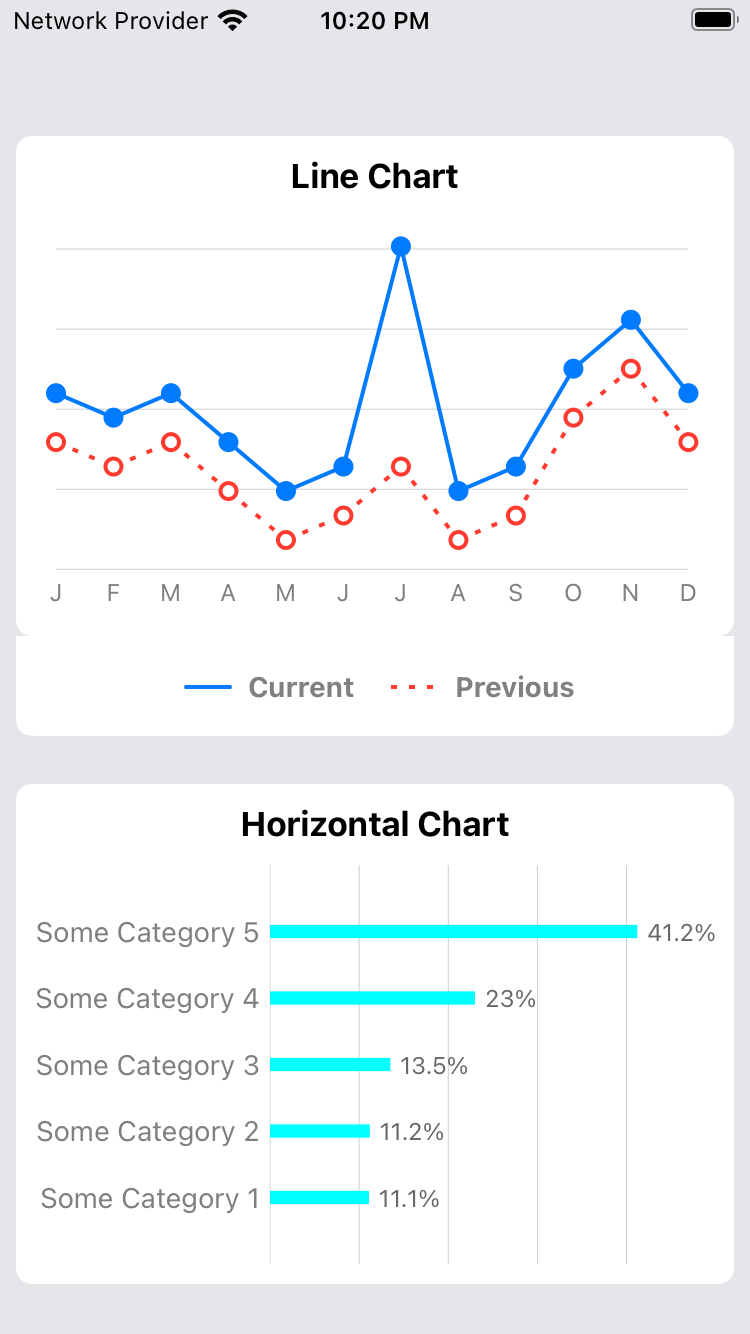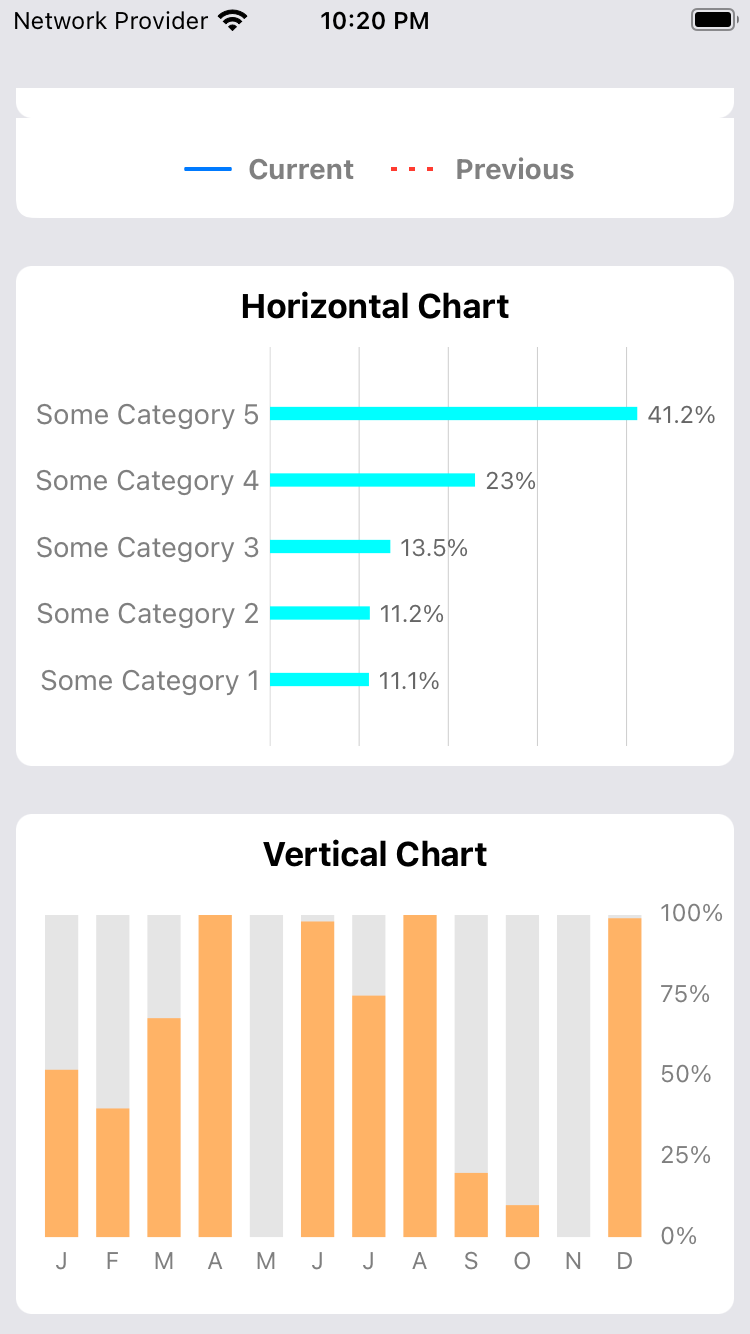Multiple charts within UITableView
Before reading this post, kindly refer previous 3 posts i.e. Horizontal Bar Chart, Vertical Bar Chart & Line Chart inorder to get a clear understanding from this post.
In this post we will look into one of the practical approaches for implementing multiple charts within UITableView.
(Refer Final Result for screenshots).
Final Result :


Let’s start by creating LineChartForDemo :-
import Charts
class LineChartForDemo: LineChartView {
struct Constants {
static let currentLineDataSetLabel = "currentLineDataSetLabel"
static let previousLineDataSetLabel = "previousLineDataSetLabel"
}
let months = ["J", "F", "M", "A", "M", "J", "J", "A", "S", "O", "N", "D"]
let arrVal1 = [15.0, 14.0, 15.0, 13.0, 11.0, 12.0, 21.0, 11.0, 12.0, 16.0, 18.0, 15.0]
let arrVal2 = [13.0, 12.0, 13.0, 11.0, 9.0, 10.0, 12.0, 9.0, 10.0, 14.0, 16.0, 13.0]
override init(frame: CGRect) {
super.init(frame: frame)
setupData()
}
required init?(coder aDecoder: NSCoder) {
super.init(coder: aDecoder)
}
func setupLineChart() {
// Graph Position
extraLeftOffset = 20.0
extraTopOffset = 5.0
extraBottomOffset = 15.0
extraRightOffset = 0.0
// Graph Config
leftAxis.enabled = false
xAxis.labelPosition = .bottom
rightAxis.drawZeroLineEnabled = false
legend.enabled = false
drawGridBackgroundEnabled = false
xAxis.granularity = 1.0
xAxis.labelCount = 12
pinchZoomEnabled = false
doubleTapToZoomEnabled = false
rightAxis.spaceBottom = 0
scaleXEnabled = false
scaleYEnabled = false
// Graph X Axis and Right Axis Color
backgroundColor = .white
xAxis.axisLineColor = .clear
xAxis.gridColor = UIColor.clear
xAxis.labelTextColor = UIColor.black.withAlphaComponent(0.5)
rightAxis.gridColor = UIColor.black.withAlphaComponent(0.2)
rightAxis.axisLineColor = UIColor.clear
rightAxis.labelTextColor = UIColor.clear
// Graph X Axis and Right Axis Font
rightAxis.labelFont = UIFont.systemFont(ofSize: 12, weight: .regular)
xAxis.labelFont = UIFont.systemFont(ofSize: 12, weight: .regular)
}
func lineDataEntry(xValue: Double,
yValue: Double) -> LineChartDataEntry {
return LineChartDataEntry(xValue: xValue, yValue: yValue)
}
func setupData(showPrevious: Bool = true) {
setupLineChart()
var currentLineEntries = [ChartDataEntry]()
var previousLineEntries = [ChartDataEntry]()
for interval in 0..<months.count {
currentLineEntries.append(lineDataEntry(xValue: Double(interval), yValue: Double(arrVal1[interval])))
if showPrevious {
previousLineEntries.append(lineDataEntry(xValue: Double(interval), yValue:Double(arrVal2[interval])))
}
}
xAxis.valueFormatter = IndexAxisValueFormatter(values: months)
/* Line data set */
let currentLineDataSet = dataSetWith(entries: currentLineEntries,
color: UIColor.systemBlue,
label: Constants.currentLineDataSetLabel)
if !previousLineEntries.isEmpty {
let previousLineDataSet = dataSetWith(entries: previousLineEntries,
color: UIColor.systemRed,
label: Constants.previousLineDataSetLabel)
var combinedData = LineChartData()
if showPrevious {
combinedData = LineChartData(dataSets: [currentLineDataSet, previousLineDataSet])
}
else {
combinedData = LineChartData(dataSets: [currentLineDataSet])
}
data = combinedData
rightAxis.labelCount = 5 // Update as per your needs
}
notifyDataSetChanged()
}
Next we will create VerticalChartForDemo :-
import Charts
class VerticalChartForDemo: BarChartView {
let months = ["J","F","M","A","M","J","J","A","S","O","N","D"]
let percentages = [52.0, 40.0, 68.0, 100.0, 0.0, 98.0, 75.0, 100.0, 20.0, 10.0, 0.0, 99.0]
override init(frame: CGRect) {
super.init(frame: frame)
setupData()
}
required init?(coder aDecoder: NSCoder) {
super.init(coder: aDecoder)
}
func setupVerticalChart() {
// Graph Position
extraLeftOffset = 0
extraTopOffset = 20
extraBottomOffset = 20
extraRightOffset = 0
leftAxis.enabled = false
xAxis.labelPosition = .bottom
legend.enabled = false
drawGridBackgroundEnabled = false
xAxis.granularity = 1.0
xAxis.labelCount = 12
pinchZoomEnabled = false
doubleTapToZoomEnabled = false
backgroundColor = .white
// Graph X Axis and Right Axis Color
xAxis.axisLineColor = .clear
xAxis.gridColor = .clear
xAxis.labelTextColor = UIColor.black.withAlphaComponent(0.5)
rightAxis.gridColor = .clear
rightAxis.axisLineColor = .clear
rightAxis.labelTextColor = UIColor.black.withAlphaComponent(0.5)
// Graph X Axis and Right Axis Font
rightAxis.labelFont = UIFont.systemFont(ofSize: 12)
xAxis.labelFont = UIFont.systemFont(ofSize: 12)
rightAxis.drawZeroLineEnabled = false
rightAxis.drawAxisLineEnabled = false
}
func setupData() {
setupVerticalChart()
var barEntries = [BarChartDataEntry]()
for interval in 0..<months.count {
let val1 = Double(percentages[interval])
let val2 = 100 - val1
barEntries.append(BarChartDataEntry(x: Double(interval), yValues: [val1, val2]))
}
let barDataSet = dataSetWith(entries: barEntries,
colors: [UIColor.orange.withAlphaComponent(0.6), UIColor.black.withAlphaComponent(0.1)],
highlightColor: UIColor.orange.withAlphaComponent(1.0),
label: "label")
xAxis.valueFormatter = IndexAxisValueFormatter(values: months)
setupRightAxisFormatter()
let barData = BarChartData(dataSet: barDataSet)
barData.barWidth = 0.65
data = barData
barDataSet.axisDependency = .right
notifyDataSetChanged()
}
func setupRightAxisFormatter() {
let rightAxisFormatter = NumberFormatter()
rightAxisFormatter.positiveSuffix = "%"
rightAxis.valueFormatter = DefaultAxisValueFormatter(formatter: rightAxisFormatter)
rightAxis.axisMinimum = 0
rightAxis.axisMaximum = 100
rightAxis.granularity = 25
}
func dataSetWith(entries: [BarChartDataEntry],
colors: [UIColor] = [.black],
highlightColor: UIColor,
label: String = "") -> BarChartDataSet {
let barDataSet = BarChartDataSet(entries: entries, label: label)
barDataSet.drawIconsEnabled = false
barDataSet.drawValuesEnabled = false
barDataSet.colors = colors
barDataSet.highlightColor = highlightColor
barDataSet.highlightAlpha = 1.0
barDataSet.highlightLineWidth = 0
return barDataSet
}
}
Lastly we will create HorizontalBarChartView:-
import Charts
class HorizontalChartDemo: HorizontalBarChartView {
let unitsSold = [11.1, 11.2, 13.5, 23.0, 41.2]
let singleLineCategory = ["Some Category 1", "Some Category 2", "Some Category 3", "Some Category 4", "Some Category 5"]
override init(frame: CGRect) {
super.init(frame: frame)
setupData()
}
required init?(coder aDecoder: NSCoder) {
super.init(coder: aDecoder)
}
func setupGraphSettings() {
extraLeftOffset = 0.0
extraTopOffset = 0.0
extraBottomOffset = 0.0
extraRightOffset = 30.0
pinchZoomEnabled = false
doubleTapToZoomEnabled = false
scaleXEnabled = false
scaleYEnabled = false
// Graph Config
legend.enabled = false
xAxis.enabled = true
xAxis.labelPosition = .bottom
xAxis.drawAxisLineEnabled = false
xAxis.drawGridLinesEnabled = false
xAxis.drawLabelsEnabled = true
xAxis.axisMinimum = -1
xAxis.axisMaximum = 5
xAxis.granularityEnabled = true
xAxis.granularity = 1
leftAxis.enabled = true
leftAxis.drawLabelsEnabled = false
leftAxis.axisMinimum = 0
rightAxis.enabled = false
// Graph Color & Font settings
backgroundColor = .white
leftAxis.zeroLineColor = UIColor.clear
leftAxis.axisLineColor = UIColor.clear
leftAxis.gridColor = UIColor.black.withAlphaComponent(0.2)
xAxis.labelFont = UIFont.systemFont(ofSize: 14)
xAxis.labelTextColor = UIColor.black.withAlphaComponent(0.5)
}
func dataSetWith(entries: [BarChartDataEntry],
colors: [UIColor] = [.black],
highlightColor: UIColor,
label: String = "") -> BarChartDataSet {
let barDataSet = BarChartDataSet(entries: entries, label: label)
barDataSet.valueFont = UIFont.systemFont(ofSize: 14)
barDataSet.drawValuesEnabled = true
barDataSet.colors = colors
barDataSet.highlightColor = highlightColor
return barDataSet
}
func setupData() {
setupGraphSettings()
xAxis.valueFormatter = IndexAxisValueFormatter(values: singleLineCategory)
var arrEntries = [BarChartDataEntry]()
for interval in 0..<unitsSold.count {
arrEntries.append(BarChartDataEntry(x: Double(interval), y: Double(unitsSold[interval])))
}
let arrarDataSet = dataSetWith(entries: arrEntries,
colors: [UIColor.cyan],
highlightColor: UIColor.black,
label: "label1")
let barData = BarChartData(dataSet: arrarDataSet)
setupPercentValueFormatter(barData: barData)
barData.barWidth = 0.2
data = barData
data?.notifyDataChanged()
}
func setupPercentValueFormatter(barData : BarChartData) {
let percentAxisFormatter = NumberFormatter()
percentAxisFormatter.numberStyle = .decimal
percentAxisFormatter.positiveSuffix = "%"
percentAxisFormatter.maximumFractionDigits = 2
barData.setValueFormatter(DefaultValueFormatter(formatter: percentAxisFormatter))
barData.setValueFont(UIFont.systemFont(ofSize: 12))
barData.setValueTextColor(UIColor.black.withAlphaComponent(0.6))
}
}
Now we are ready to create DemoChartFactory :-
enum DemoChartFactory:Int {
case line
case horizontal
case vertical
var title:String {
switch self {
case .line:
return "Line Chart"
case .horizontal:
return "Horizontal Chart"
case .vertical:
return "Vertical Chart"
}
}
var chartView:UIView {
switch self {
case .line:
return LineChartForDemo()
case .horizontal:
return HorizontalChartDemo()
case .vertical:
return VerticalChartForDemo()
}
}
static let count: Int = {
var max: Int = 0
while let _ = DemoChartFactory(rawValue: max) { max += 1 }
return max
}()
}
Next, create required TableViewCell :-
import UIKit
class TableViewCell: UITableViewCell {
@IBOutlet weak var chartViewContainer : UIView!
@IBOutlet weak var lblTitle : UILabel!
var factory: DemoChartFactory?
override func awakeFromNib() {
super.awakeFromNib()
// Initialization code
self.layer.cornerRadius = 8.0
self.clipsToBounds = true
}
override func setSelected(_ selected: Bool, animated: Bool) {
super.setSelected(selected, animated: animated)
// Configure the view for the selected state
}
}
Now, go to required ViewController to register TableViewCell & setup UITableViewDataSource methods :
class ViewController: UIViewController {
@IBOutlet weak var tableView:UITableView!
override func viewDidLoad() {
super.viewDidLoad()
// Do any additional setup after loading the view.
tableView.register(UINib(nibName: "TableViewCell", bundle: nil), forCellReuseIdentifier: "Cell")
}
}
extension ViewController : UITableViewDataSource {
func numberOfSections(in tableView: UITableView) -> Int { DemoChartFactory.count }
func tableView(_ tableView: UITableView, numberOfRowsInSection section: Int) -> Int { 1 }
func tableView(_ tableView: UITableView, cellForRowAt indexPath: IndexPath) -> UITableViewCell {
guard let cell = tableView.dequeueReusableCell(withIdentifier: "Cell") as? TableViewCell else {
return UITableViewCell()
}
return configureCell(indexPath.section, cell: cell)
}
func configureCell(_ index:Int, cell:TableViewCell) -> UITableViewCell {
cell.factory = DemoChartFactory(rawValue: index)
return cell
}
}
Hope above post was informative and useful.